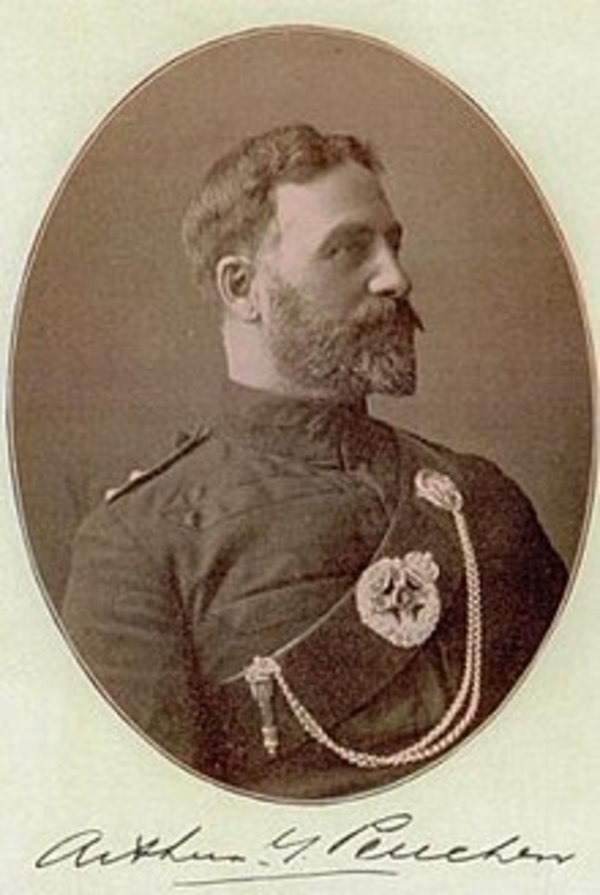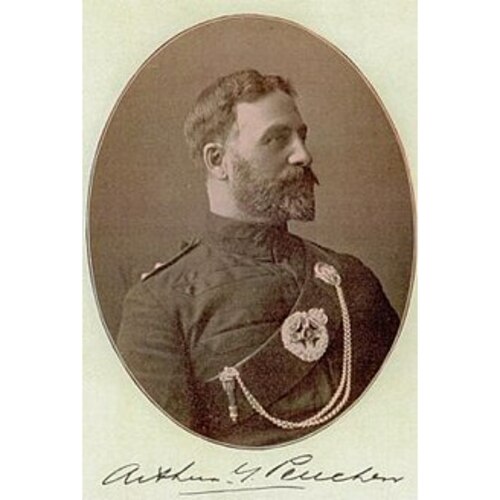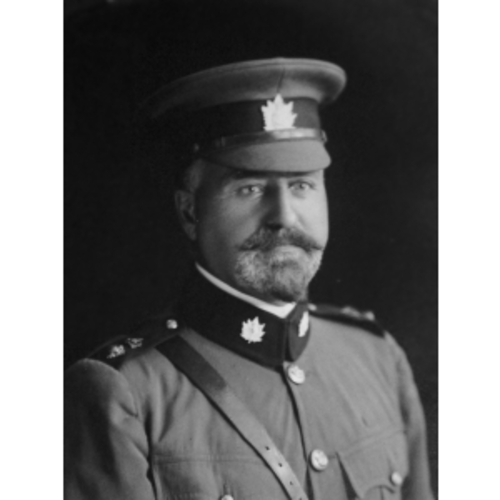
Source: Courtesy of Wikimedia Commons
PEUCHEN, ARTHUR GODFREY, businessman, militia officer, and yachtsman; b. 18 April 1859 in Montreal, son of Godfrey E. Peuchen and Eliza Eleanor Clarke; m. 26 April 1893 Margaret Thomson in Toronto, and they had a daughter and a son; d. there 7 Dec. 1929.
Arthur G. Peuchen’s maternal grandfather had been manager of the London, Brighton and South Coast Railway in England. His Prussian father was a railway contractor in South America before he immigrated to Canada in 1850 to work for the Grand Trunk; in 1859 he was a wine merchant. Though born in Montreal, Arthur was raised in Toronto and he attended private schools in Ontario and England. His business career began in Toronto around 1879–80, as a clerk and salesman, and by 1882 he had started to manufacture paint. Moving through various partnerships, he emerged about 1893 as manager of the Canada Paint Company, of which his brother Stanley Cooper was superintendent. Peuchen is said to have been the first manufacturer in Canada to capitalize on pre-mixed, colour-blended paints. Within three years, in Peuchen and Company, he had also begun to specialize in the production of acetic acid and aceto-based pigment.
To utilize his method of distilling wood alcohol and acetone from hardwood, in 1897 he founded the Standard Chemical Company of Toronto Limited in association with entrepreneur William Mackenzie, Mackenzie’s brother Ewan, Orillia lumberman William Thomson, and others. Standard Chemical opened factories in Ontario at Sault Ste Marie, Fenelon Falls, Deseronto, Longford Mills, South River, Thornbury, and Parry Sound and in Quebec at Fassett, Cookshire, and Mont-Tremblant. In 1909 the firm began making formaldehyde. Two years later it was expanded – Peuchen bought large timber limits in Alberta from Senator Peter McLaren – and reorganized as the Standard Chemical, Iron and Lumber Company.
Peuchen had been a protégé of Toronto financier Henry Mill Pellatt*, who was also a militia officer in the Queen’s Own Rifles of Canada. Peuchen joined this regiment at the age of 17; he was promoted second lieutenant in 1888, captain in 1894, and major in 1904. In 1911 he was the marshalling officer in charge of the Indian cavalry in London during the procession for the coronation of King George V. Photographs of him in uniform, with his precisely trimmed beard, present an officer of striking appearance.
A bluff, opinionated millionaire, Peuchen used his success in business and the military as stepping stones in Toronto society. He built a country residence, Woodlands, near Shanty Bay on Lake Simcoe, complete with a marina, tennis courts, and riding stables. The Anglican church and a number of hospital charities enjoyed his support. He was a member of the Albany and Toronto Hunt clubs, among others, and a vice-commodore of the Royal Canadian Yacht Club. His 65-foot yacht, the Vreda, regularly captured trophies in Great Lakes regattas.
Peuchen was a seasoned traveller who had crossed the Atlantic at least 40 times. In early 1912 he was in England, where he approached Lord Haldane of the War Office about supplying acetone for making explosives. He booked his return passage on the premier voyage of the Titanic. On 14 April it hit an iceberg, but he did not expect it to founder – he left $200,000 in securities in his cabin when he went out to survey the damage. Recognized as an experienced yachtsman, he was ordered by a ship’s officer, Charles Herbert Lightoller, into a lifeboat with 20 women and 3 other men. Once in the boat, he did not assert himself, but allowed Robert Hichens, the quartermaster who was at the tiller, to remain there rather than row. The women were terribly uncoordinated. In the end, it was Denver socialite Margaret Brown (later dubbed the Unsinkable Molly Brown) who challenged Hichens and took charge of the boat, which was rescued by the Carpathia.
Peuchen was the only Canadian to testify, on 23 April, at the American Senate’s inquiry into the sinking and the loss of more than 1,500 lives. An impartial, expert witness, he was critical of the seamanship aboard the Titanic. Its crew, he said, “was what we would call in yachting terms a scratch crew, brought from different vessels. They might be the best, but they had not been accustomed to working together.” In the lifeboat, Hichens had refused his help. He was “swearing a great deal, and was very disagreeable . . . and he told me he was in command,” Peuchen testified. “I knew I was perfectly powerless.” Back in Toronto, he faced both criticism and praise. Under Edwardian standards, to have survived was judged unbecoming conduct for an officer and a gentleman. The Toronto Mail and Empire discredited him as “a man who had to defend himself before the necessity for the defence was apparent.” According to another taunt, “He said he was a yachtsman so he could get off the Titanic, and if there had been a fire, he would have said he was a fireman.” He was nonetheless welcomed back from Washington by his fellow officers in the QOR; on 21 May he was promoted lieutenant-colonel and assumed command of the regiment’s 1st Battalion. His reputation from the Titanic would be somewhat rehabilitated in 1935 when C. H. Lightoller published his memoirs, in which he wrote that Peuchen had been unfairly criticized for carrying out a direct order.
When World War I broke out in 1914, Peuchen retired from Standard Chemical, which by then had acquired all the companies working in the wood distillation industry in Canada. In November 1915 he stepped down from his militia command. Following the conflict, he lost much of his fortune through bad investments; in December 1918 he was sued by Peter McLaren on an overdue promissory note. He nevertheless retained his house, an apartment in London, and Woodlands, which he would sell in 1928, and he continued to own McLaren Lumber in Alberta and the mill of Prince Albert Lumber in Saskatchewan. During the last years of his life he spent a good deal of time living in Hinton, Alta. Peuchen died in Toronto five weeks after the stock-market crash of 1929, leaving an estate valued at about $67,000. In 1987 his wallet was recovered from the wreck of the Titanic; inside were his business card and some streetcar tickets.
ANQ-M, CE601-S63, 5 juin 1859. AO, RG 22-305, no.63684; RG 80-5-0-211, no.14413. LAC, RG 31, C1, 1901, Toronto, Ward 2, div.34: 4. Toronto Daily Star, 25 March, 26–27 April 1912; 8 Nov. 1915; 8 Feb. 1916; 13 Dec. 1918; 9 Dec. 1929. Hugh Brewster, “Sinking sensation,” Toronto Life (Toronto), 31 (1997), no.7: 55–65. Canada Gazette, 17 Nov. 1888: 864. Canadian men and women of the time (Morgan; 1912). Cyclopædia of Canadian biog. (Rose and Charlesworth), vol.3. Directory, Toronto, 1875–99. Encyclopaedia of Canadian biography . . . , vol.2. “Encyclopedia Titanica”: www.encyclopedia-titanica.org. (consulted 18 June 2004). Alan Hustak, Titanic: the Canadian story (Montreal, 1998). Ontario Gazette (Toronto), 19 June 1897: 982. “Titanic inquiry project,” comp. and ed. Rob Ottmers and Bill Wormstedt: www.titanicinquiry.org. (consulted 18 June 2004). U.S., Senate, Committee on commerce, Titanic disaster, 62nd Congress, 2nd session, 1912, Senate report 806 (Washington, 1912).
Cite This Article
Alan Hustak, “PEUCHEN, ARTHUR GODFREY,” in Dictionary of Canadian Biography, vol. 15, University of Toronto/Université Laval, 2003–, accessed April 5, 2025, https://www.biographi.ca/en/bio/peuchen_arthur_godfrey_15E.html.
The citation above shows the format for footnotes and endnotes according to the Chicago manual of style (16th edition). Information to be used in other citation formats:
| Permalink: | https://www.biographi.ca/en/bio/peuchen_arthur_godfrey_15E.html |
| Author of Article: | Alan Hustak |
| Title of Article: | PEUCHEN, ARTHUR GODFREY |
| Publication Name: | Dictionary of Canadian Biography, vol. 15 |
| Publisher: | University of Toronto/Université Laval |
| Year of publication: | 2005 |
| Year of revision: | 2013 |
| Access Date: | April 5, 2025 |




